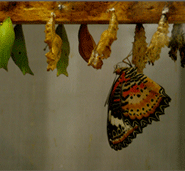This is an essay about old eyes that seek their place in the present. Though it is set in America, it breathes relevantly into the Indian metropolis, where both buildings and ideas are in-progress, where the rubble holds a history, even as it morphs onwards.
We arrived by bicycle, hoisted our rides up a staircase sloughing brick. Outside it was sunny and still, but the building had its own cool breeze – like it was breathing up the smell of wet dirt, sighing a sigh of spray paint and old puddle. This was a place for machines, once; empty now, the inhuman scale of the walls and ceilings shrunk us to almost nothing. We picked a path through near-vegetative waste – plastic bags, useless bits of wood, the requisite tires – and the cautious tickticktick of our freewheels sent up new sound into old silence.
I had come to this city the day before: Cleveland, a proud notch on America’s Rust Belt, a place where my grandfather ran a family bank and my great aunt was one of the city’s first female judges. Here, in a stately neighborhood called Shaker Heights, my mother and her nine siblings made mayhem around a giant dining room table and menaced the nuns at their Catholic schools. The older ones drove their dad’s shiny station wagon straight into the 1960’s; the younger ones practiced their tennis serves and waterskiing tricks.
In those days, this factory was probably open. What did it produce? Car parts, stereos? The camera my grandfather used to photograph his darlings on trips to the beach, the guitars my uncles played? Or maybe simpler things – nails or ball bearings or graphite pencils – that haven’t been made here for so long that we forget they require making? Nothing on my person, I don’t think, was manufactured in this country.
We carried our bikes up stairways waterfalling with decay, and left them to rest against giant cement pillars. This place could be a parking garage, except the only way to get cars up and down would be by freight elevator. I find two dark shafts, and sticking my head into the black must quickens my pulse. I am taking pictures like crazy, taken with the strange beauty of this rot and the way it frames my companions. Or maybe it’s the sheer size of the place, the way thousands of windows and holes let in light like a prayer. One colossal space has a clerestory, just like a Renaissance cathedral – only here, men worshipped progress.
But of course I’m not the first to see beauty in ruination, nor will I be the last. This old factory is Machu Picchu Hampi Parthenon Giza; these days, it seems like this country’s best years are behind it. Though my generation was not born into this recession, we’re still cutting our teeth on it. And scuffing through the detritus, I feel a sense of pride and potential, like fuck waterskiing; we’ve got work to do.
Later, we visit another building in the same part of town – same brick, same sort of smokestack. But here we find the ghosts of industry reincarnate: young people pulling screens through giant vats of pulp. They’re making fine paper, shipping it out to artists and writers. Binding books, teaching others the process. And around the block, they tell me, they have studios of their own. Here, they churn out blank canvases, and they seem to know it. Each batch is a new beginning; each sheet is exactly what this city needs.
Angela Jane Evancie writes, photographs and makes radio in her ever-changing surroundings. She is currently based in Eugene, Oregon.
Editor's Note.
The mysterious inner life, like a mischievous child peering into the living room after his bedtime, shows itself at the oddest, most inconvenient hours. You are at your own party, surrounded by food and alcohol and laughter and then poof! There it is, invisible and omnipresent. Your inner life, sweeping in for the kill, overwhelms all your senses and sound reasoning.
Read MoreAlso in this issue
Illusion: Seeing Beyond Seeing
Meaning: In Search of Significance.
Melody: A Different Tune
Rhythm: Ordering Time















